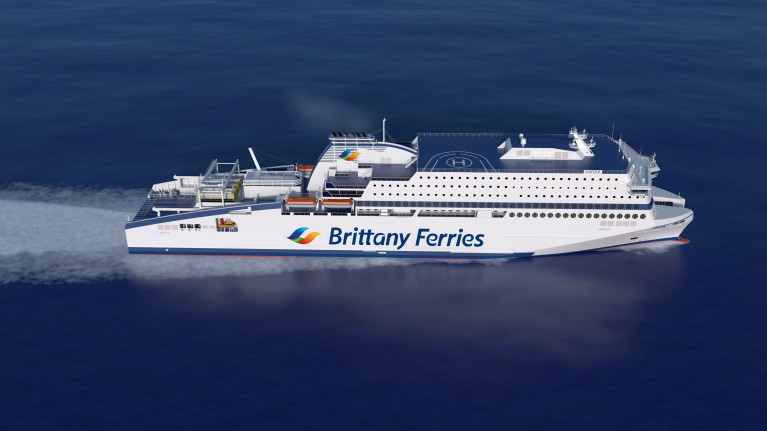Displaying items by tag: FSG Flensburger
Operator Brittany Ferries and Somanor confirm the termination of the Honfleur shipbuilding contract.
The ferry company and Somanor confirmed the termination, on 17th June 2020, of the shipbuilding contract for Honfleur, a ferry powered by Liquefied Natural Gas (LNG).
Somanor SAS (a semi-public company bringing together the Normandy Region, and the Calvados and Manche Departments), and Brittany Ferries have confirmed the termination of the construction contract for Honfleur with the Flensburger Schiffbau-Gesellschaft (FSG) shipyard.
(Afloat adds the same German shipyard built cruiseferry W.B. Yeats (for ICG, parent company of Irish Ferries) had delayed construction of Honfleur. In addition as reported, ICG's order for a larger version of the cruiseferry was recently cancelled)
The Honfleur has been under construction in Flensburg, Germany, since 2017. Honfleur was originally scheduled to enter service in June 2019, but delivery of the vessel has been postponed several times due to persistent financial problems encountered by the yard’s management.
The change of main shareholder in September 2019, with the arrival of Lars Windhorst and the Tennor group, did not allow the yard to return to growth and competitiveness.
With the surprise announcement that the yard was placed under the protection of the Commercial Court in May 2020, and unsuccessful discussions with the current management of FSG and its main creditors, Somanor and Brittany Ferries, the backers of Honfleur, acknowledged that they had lost confidence in the yard’s ability to complete the vessel within a reasonable period of time.
Afloat also adds the newbuild was to enter service on the English Channel based out of Portsmouth.
Brittany Ferries UK-France Cruiseferry Honfleur Celebrates Second Construction Milestone
#FerryNews - Honfleur, Brittany Ferries newbuild cruiseferry celebrated a second milestone with a keel-laying ceremony this week. The occasion marked a leap forward in sustainable design, one that is at least as significant as the ship’s innovative liquefied natural gas (LNG) power deliver system.
Afloat highlights that the cruiseferry is to enter service in 2019 on the UK-France route: Portsmouth-Caen (Ouistreham). The Normandy port is situated close to the cruiseferry's namesake coastal city of Honfleur. At more than 42,000 gross tonnage, the new ship will become the largest in the fleet, surpassing current flagship Pont-Aven which operates Cork-Roscoff in addition UK-Spain services.
The keel-laying ceremony marked the point at which the first hull blocks are lowered onto a slipway. After they are joined, Honfleur’s blocks will form a complete a hull that promises to glide through the seas far more efficiently than ships of the past. Fuel consumption will be lower and ride quality will be better for passengers.
“Technology has transformed the way we design hulls,” says Heike Billerbeck, head of ship theory and hydrodynamics at FSG, the German shipyard at which Honfleur is being built. “Over the last 20 to 30 years we’ve reduced wave resistance by between a third and a half.”
Heike and her team spent around three months creating a digital model of Honfleur’s hull, and testing it using computational fluid dynamic software.
This allowed them to visualise the size and angle of the bow wave and wake the ship will create: smaller waves mean less wasted energy. They also created animations of how Honfleur will perform in heavy seas as well as calculating exactly how much power Honfleur will need to sail at a given speed, ensuring she meets efficiency targets set by Brittany Ferries.
The shape of the hull – of which the keel is the very lowest beam running from bow to stern – has a huge impact on a ship’s manoeuvrability in port and its stability at sea. A good design reduces vibration that can sometimes be felt from the propeller which means Honfleur will be a more comfortable ship, as well as being better for the environment.
“Passengers will never see Honfleur’s hull, but they will certainly feel its benefit,” said Brice Robinson, Brittany Ferries naval architect, speaking from the keel laying ceremony. “Think of your car. It has been designed to slip through the air as cleanly as possible to maximise its fuel efficiency. The hull of a ship is just the same. It’s just a question of hydrodynamics rather than aerodynamics.”
The ‘coins in the keel’
The moment at which the keel is laid is marked by an ancient traditional coin-laying ceremony. This week, coins were placed in Honfleur’s keel by representatives of Brittany Ferries and FSG as a token of good fortune.
The origins of this tradition can be traced back to Roman times, when coins were placed into the mouths of soldiers killed in war in order to pay Charon, the mythological ferryman, to carry them across the River Styx.
In the past keel laying took on greater significance. For wooden ships, this was often the first time a vessel took physical shape. Now this happens with the earlier steel-cutting ceremony, after which a shipyard spends several months building huge sections of hull which are then craned onto a slipway, then welded together.
But the moment that the first of those steel sections is laid onto the slipway (from which Honfleur’s finished hull will be launched into the Baltic this December) remains an important moment.
For more visit the Honfleur website here.





























































